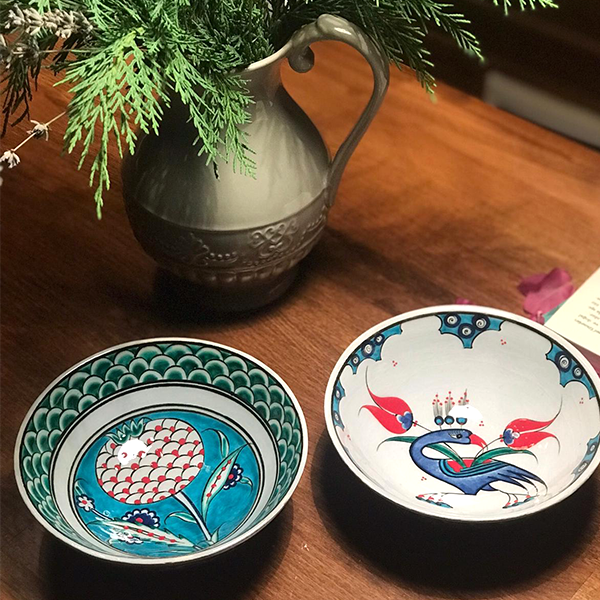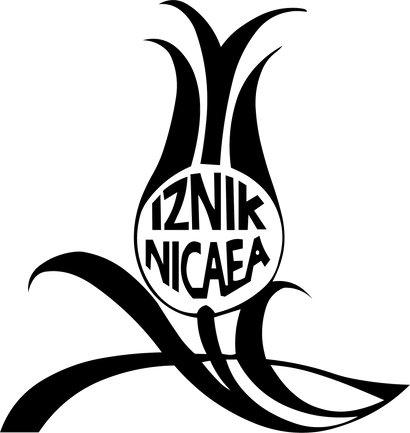WELCOME TO THE WORLD OF IZNIK
WELCOME TO THE WORLD OF IZNIK

The Art of Mehmet Gursoy By Moira VINCENTELLI
February 01, 2017 3 min read
Mehmet Gürsoy’s ceramics are made from a fine white earthenware and take traditional forms elegant vases with narrow pedestal bases and tall flaring necks, tall bottles with narrow necks and a bulbous ring at their base, beakers and generous plates with delicately shaped eims which seem to echo the floral motifs that dominate the decoration. These are the exotic flowers of the seventeenth century – tulips, carnations, roses and daisies, each with its distinctive shape balanced by swirling leaves.
Sometimes the heads twist around as if blowing in the wind. The graphic quality of the stems and outlines is vibrant and dynamic and the whole design is orchestrated like a symphony, each element playing its part and essential to the final effect. Sometimes it is symmetrical but, more often, subtly balanced with asymmetrical compositions of arching stems, leaves and flowers. The colours too seem to sing – blues, reds, greens and turquoises – although many of the designs are also produced in the more restrained combination of blue and white. Peacocks, fish and ships are other popular motifs. The use of calligraphy is one of the great feats of teh Islamic tradition and Mehmet Gürsoy also produces new designs using these ancient and spiritual forms. There is endless variety based on a limited range of set motifs, many of which have distinct names and long histories.
Designs are drawn on a waxy paper and then pricked to make stencils through which charcoal dust is brushed to give a guide for the fine outline drawing. Colours are painted on and then covered with a clear glaze before the final firing. In the latter part of the twentieth century Kütahya moved over from wood-firing to electric kilns in adesire to improve the smoky atmosphere of the city. Kiln losses have diminished and the product is more predictable, but some people regret the loss of variability and the slight imperfections that come from a wood-firing. By comparison with early work of the Iznik potters the modern work is highly controlled, one might even say tamed, albeit spectacular. The great technical achievement of the ancient Turkish wares was the ability to achieve the vibrant colours fired under glaze rather than as enamels on top of the glaze. Thet quality is stil there today. The ideology of the Western art tradition that values above all innovation, exerts its power in other cultures where innovation may not be the primary value. It is a healthy lesson for contemporary audiences to see demonstrated such ‘old fashioned’ values of fine craft-work. The elegance and refinement of this work flows, not merely from an individual lifetime of discipline and practice, but from generations, even centuries, of individuals who have produced this work. Of course new techonologies and machinery can speed up some of the processes, ceramic bodies may be more consistent, designs can be printed rather than hand-painted, but the discerning eye can always tell the difference. The hand-painted pieces are designed for the connoisseur’s eye. There is just that frisson of risk and danger that it could all be spoilt by one mistake.
Altough some of the artists in Kutahya produce entirely new designs, most accept the parameters of tradition and produce variations on a theme. Individual expression is not the primary creative impulse. Thus they straddle two different art ideologies – the western one that stresses innovation and the eastern one that values respect for ancient traditions. Iznik has proved itself capable of inspiring renewal and innovation. At Aberystwyth Mehmet Gürsoy amply demonstrated how he is indeed a modern master of an ancient art tradition.
Prof. Moira Vincentelli is Senior lecturer in Art History and Curator of the Ceramic Collection and Archive at the University of Wales, Aberystwyth.
Subscribe
Sign up to get the latest on sales, new releases and more …


